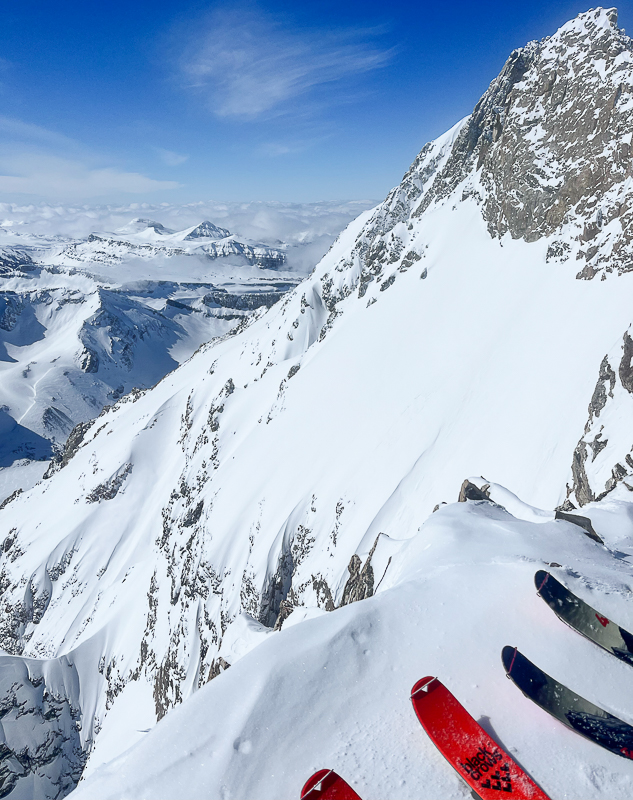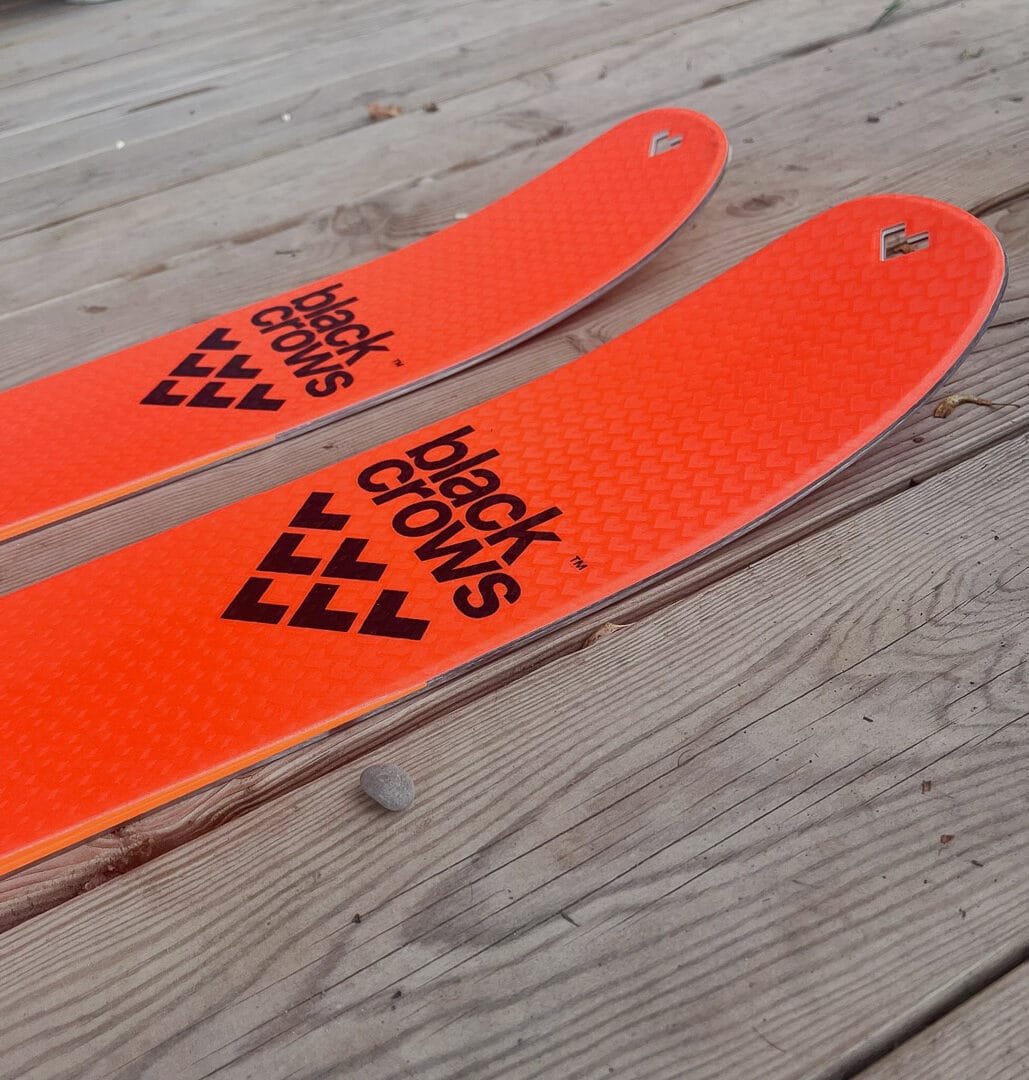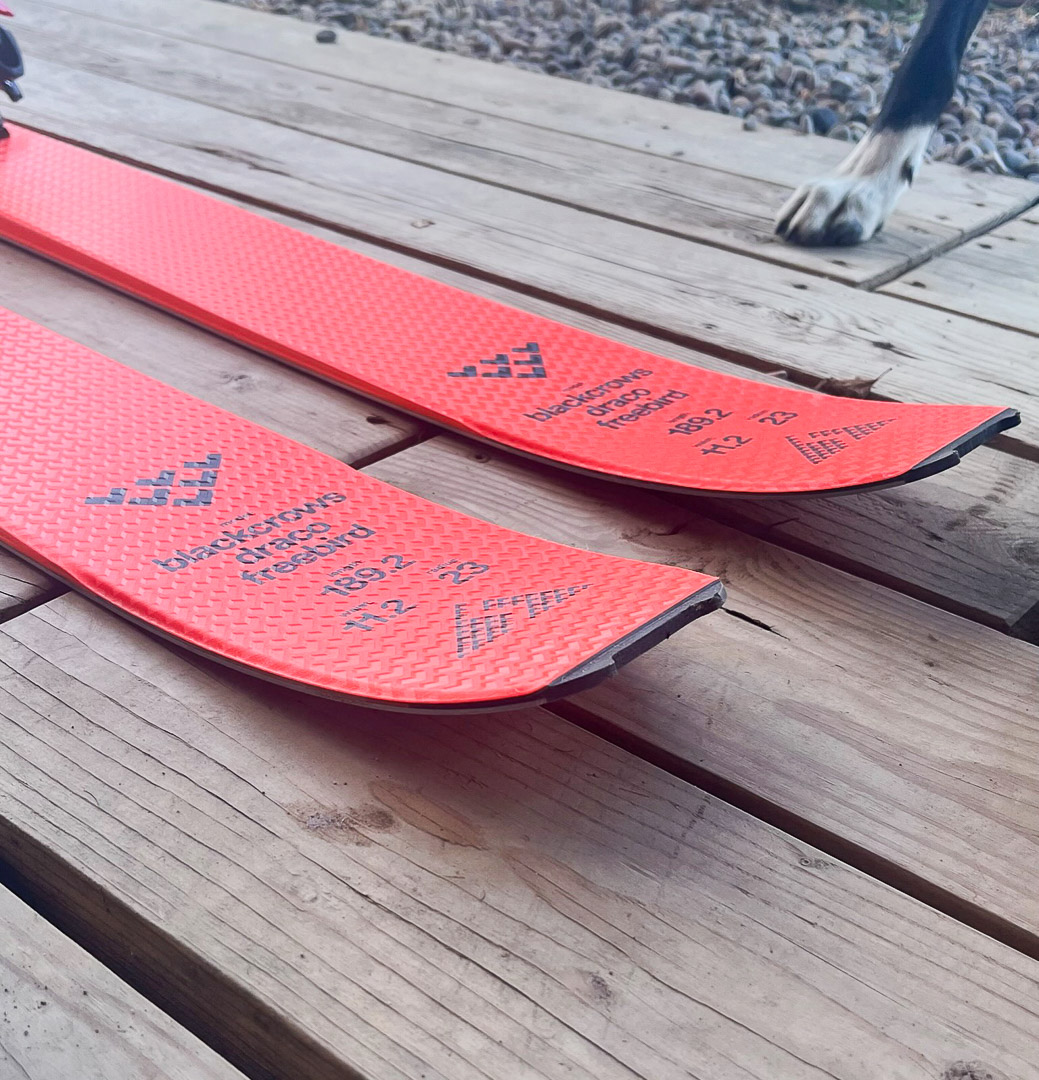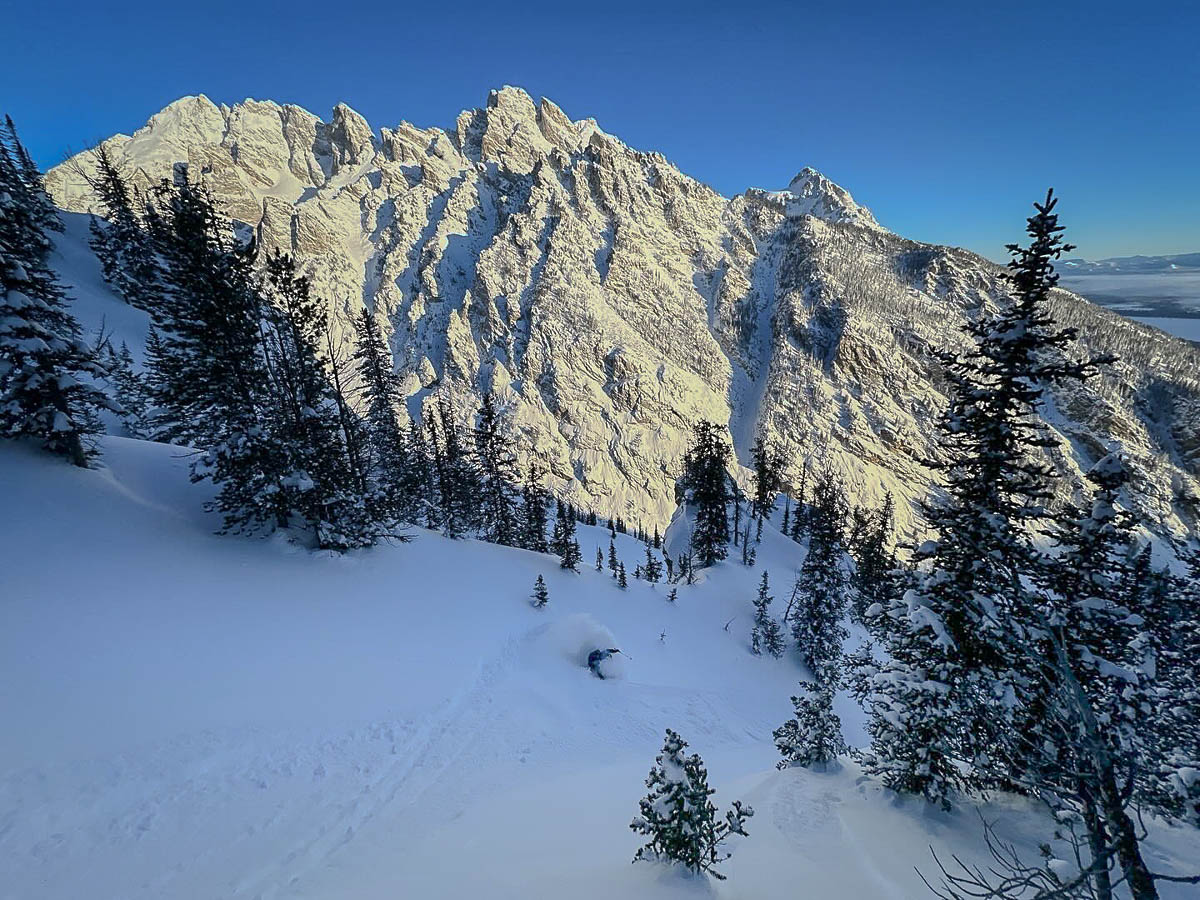Black Crows needs no further introduction around these parts; their Green, Pink, and Red topsheets are ubiquitous in the North American ski touring scene. The Chamonix-based brand has enjoyed huge popularity and “cool factor” in recent years, owing not just to bright topsheets and great marketing but also a wide variety of good skis. From the light and skinny Mentis, the friendly and forgiving Camox, the steep skiing weapons Navis, Orb, and Solis, and the uber-traditional Corvus, the Freebird line spans an impressive range of shapes and styles. While the Anima Freebird and Ferox filled the more playful >110mm powder ski niche, they didn’t seem to share the same popularity as the 96-108mm models in the line—the Draco seems to be Black Crows attempt to rectify that disparity.
![Black Crows Draco Freebird Weight: 2050 [189.2], 1900 [181.5] Side cut: 139-112-127 [189.2], 138-110-126 [181.5] Turn radius: 23m [189.2], 21m[181.5]](https://the-high-route.com/wp-content/uploads/2024/10/Image-e1727974140749-1080x237.jpg)
Design Highlights
First spotted under the feet of pro freeriders like Nikolia Schirmer and Christina Lustenberger in 2023, the Draco’s design certainly reflects its roots in bold, fast skiing. With similar waist widths, weight, and sidecut to the Corvus Freebird, the Corvus and Draco may fit into a similar category of freeride touring skis, but the styles they suit are entirely different. Want to arc turns down an open face, hit cliffs, and perhaps you have some experience in a Super G course? The Corvus Freebird may fit the ticket. Meanwhile, if your skiing takes on a more playful twist, slashing and drifting amidst fast skiing; maybe while navigating tight terrain, this is where the Draco finds its niche.
The Draco is, in many ways, a quintessential modern freeride shape. With a long radius, minimal taper, a rockered twin tip profile, and a progressive -5cm mount point, the Draco is optimized for balanced, fast, and somewhat loose or drifty skiing. Combine this with a 1900g weight in the 181.5 cm length, and you have what appears to be an interesting blend of high performance on the downhill with a reasonable and necessary weight for this style of ski. Frankly, aside from the Orange topsheets, nothing in the specs makes it stand out from the likes of the Moment Wildcat 108, Atomic Bent 110 orits predecessor, the Ferox. That isn’t to say there isn’t value or potential for the Draco, but its specs aren’t entirely unique relative to other ~110mm, playful freeride skis on the market.
A full ABS sidewall and paulownia/poplar core give the Draco a substantial feel—they are very stiff underfoot and in the tail, with a medium stiff front ⅓ or so. We tested the 181 and 189 cm lengths and the 189 felt a few notches stiffer throughout than the 181. There is no metal reinforcement in the mounting area–a shared trait with all of the similar models listed below, this would be good for peace of mind for skiing hard on lightweight bindings with narrow mount patterns. A chevron cutout in the tip and notched tail makes for a slick and reliable skin attachment with either Black Crows branded skins/attachments, a Contour Z-Clip for skis with a tip hole, or a normal tip loop works as well. On the whole, the Corvus appeared and performed as a well-made, durable, and thoughtfully designed touring ski.
While there are worthwhile comparisons to be made with similar ski shapes like those mentioned above, I think a more interesting comparison can be made between the Draco and a ski with similar dimensions and weight, the 4FRNT Hoji.For a skier looking for a ~110mm, progressive/playful ski at around 2000g, what would make one choose the cambered, shorter radius, and twin-tipped ski vs the full rocker, longer radius, and flat tail of the Hoji? I think this comes down to a few factors; the first is turn shape.
The Draco has a loose tail, and each turn exists in a gray area (a slarve perhaps?) of tail sliding and carving. This opens up a world of nuance where it feels intuitive and easy to scrub a bit more speed with more tail washout, or drive the tails for more of a carving sensation, but each turn is still somewhere in the middle. Conversely, the Hoji feels a bit more like an on/off switch. With carving mode turned “on,” the Hoji tail stays engaged and tracks on rails until you pivot it “off” and break free into a committed slash. The other big decision point is performance in various conditions; the camber on the Draco will provide edge hold, suspension, and a more forgiving fore/aft balance point in firm, choppy, and 3D snow. Meanwhile, the Hoji will perform better in challenging conditions where we worry about catching an edge or hooking a tip like a breakable wind skin or sun crust. The Draco feels slightly more stable at speed, while the Hoji is more maneuverable at low speed.
A good way to visualize these differences is by watching the way Sam Favret and Nikolai Schirmer Nikolai Schirmer and Sam Favret are “The Draconians” (Start at 20:11), as well as Hoji (mostly on Renegades, but you get the idea) Eric Hjorleifson Winter 2021, do their thing.
Testing Setup
Black Crows was generous to lend us both the 189 cm and 181 cm lengths of the Draco, and while both came with Kingpins, I eventually gave up on the painfully heavy heels and replaced them with Marker Alpinists for a more tour-able setup. I mostly paired the Draco with the Atomic Backland XTD boot and generally felt a little under-booted with lighter models.

Field Testing
Powder/soft snow
The Draco is certainly at home in soft snow. I wouldn’t choose these as a high avalanche danger, meadow skipping ski—they feel a bit “boaty” at low speed and require a lot of input. Once up to speed, they were a blast. They floated pretty well, probably average for their width, and felt like a stable platform for big sweeping turns and small airs. As I described above, every turn, especially in powder, felt like the tails were washing out a bit, and subtle weight shifts would allow for more or less washout and speed scrubbing. While loose tails aren’t always my favorite feeling, the subtlety and ease of scrubbing a bit of speed gave me more confidence than normal to open things up and ski fast in tighter or steeper terrain than I am used to.
The Draco also generally responded well to a more forward stance and a more forward lean in boots than the mount point may suggest.
Crud/tracked/variable snow
Maybe even more so than powder, the Draco shined bright in chop, crud, and variable snow. The 189 cm was especially solid in variable 3D snow. The Draco provided excellent suspension and a stable wheelbase to recover gracefully from getting knocked forward/backward; I never felt like the tails were punishing or that the skis turned into a handful to maneuver when I inevitably got knocked into the back seat while skiing faster in more variable snow.
The Draco did okay in wind board and other flavors of breakable crust. The twin tipped tails didn;t catch noticeably upon releasing at the top of a turn, but similar to powder skiing at low speeds, the Draco felt like it needed to be muscledaround quite a bit in these conditions. The reality is that nothing can compete with reverse camber/full rocker when it comes to breakable conditions.
Firm Snow/Steeps
While I’m not here to tell you that a 110mm ski should be a go-to for firm, steep skiing, the Draco is among the best performing in such terrain/conditions I have used. The loose tail and long radius make for easy and relatively secure sliding/skidding between jump turns, where the progressive mount helps things feel balanced. Again, not the tool I’d want on a proper steep, proper firm ski run, but for mid-winter conditions with a bit of steep/firm in the mix, the Draco is up to the task.
Resort Skiing/groomers
I’m sure a good chunk of the Dracos out in the world last winter were mounted with 50/50 bindings and used inbounds at ski resorts. It seems like a pretty reasonable choice to me–with its versatility and enjoyable performance between powder, crud, and firm, the Draco seems like a solid choice for a 50/50 or lighter-weight resort ski. In the interest of not beating a dead horse, I’m sure the reader can infer what my comments related to the loose tail would be on groomers.


Conclusion
In our first look (As well as Black Crows marketing videos), the Draco was hyped as a sort of wider Atris. I can’t say I agree. The Atris I tried was quite similar to the QST Echo: Soft, damp, and lively/quick feeling. I would put the Draco more on the stable, minimal input required side of the spectrum relative to the Atris. While I’m sure some folks will enjoy both, they just aren’t that similar.
The Draco suits an interesting balance of playful, progressive skiing and being well suited to skiing fast and handling tight terrain well at speed. I often enjoy watching a brand’s athlete(s) style and terrain preferences and comparing them with my perception of a ski’s performance attributes; it’s cool when this lines up well, as is the case with folks like Christina Lusti, Nikolai Schirmer and Sam Favret. While most of us can’t ski like those chargers, a solid cohort will surely appreciate the playful and high-speed performance blend the Draco offers.
Specs
Available lengths (cm): 176.2, 181.5, 189.2
Weight: 2050 [189.2], 1900 [181.5]
Side cut: 139-112-127 [189.2], 138-110-126 [181.5]
Turn radius: 23m [189.2], 21m[181.5]
Core: Poplar, Paulownia
Build Comments: Partial ABS sidewall, notched tail, and proprietary tip attachment cutout.
Shape: Long radius, rockered tip and tail w/ camber underfoot, twin tip
Recommended Mount Point (cm from center): -5
Drill size: 3.5x9mm
Similar Models: 4FRNT Hoji, Moment Wildcat Tour 108, Black Crows Ferox, Atomic Bent 110.
Price: $1149.95






Leave a Reply
You must be logged in to post a comment.